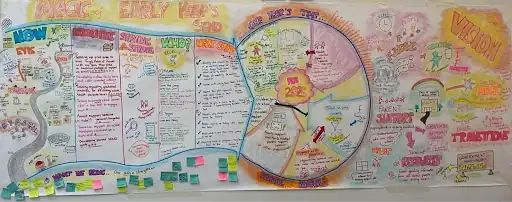Person-Driven Planning
Person-driven planning is a holistic and individualized approach aimed at empowering individuals to design a life they value. It goes beyond addressing a person's challenges or focusing on available services; instead, it emphasizes understanding and supporting their unique goals, aspirations, and preferences.
This process involves actively engaging the individual as the primary decision-maker, encouraging them to articulate their vision for the future. It starts by exploring their personal strengths, talents, and abilities, identifying the resources they already possess and the potential they have to achieve their desired outcomes. Simultaneously, it considers the barriers they may face and the types of support, emotional, physical, social, or financial, that can help them overcome those obstacles.
By prioritizing the individual’s choices and ensuring their voice is at the center of every decision, person-centered planning fosters self-determination and autonomy. This approach also encourages collaboration among family members, caregivers, and professionals to build a supportive network that respects the individual’s preferences and enhances their quality of life.
The ultimate goal of person-centered planning is to create a tailored action plan that aligns with the person’s vision for their life. This plan is flexible and evolves as the person’s circumstances, goals, and needs change, ensuring that the focus remains on enabling them to lead a fulfilling and meaningful life.

Student-Led IEP Planning
Involving students in their IEP planning is crucial for fostering self-determination. Empowering students with a voice in their IEP provides autonomy and choice in their future. Through self-directed goals and dreams, they not only shape their education but also cultivate the courage, confidence, and determination needed to navigate life with purpose and resilience.
Skills and Tips for Student-Led IEP Planning: Before the IEP
By involving students in their IEP planning, educators can create a more personalized and empowering educational experience. This approach not only supports the student's current educational goals but also prepares them for a successful and self-determined future
- Identify Strengths and Interests: With the student, describe or choose pictures of them doing activities they enjoy during a typical school day to show at the IEP meeting.
- Showcase Schoolwork: Help the student select samples of their schoolwork to demonstrate their strengths and areas of need to IEP Team Members.
- Help students build confidence to present/lead an IEP by practicing the skills 1-1 and in small groups of peers first, for instance.
- Presentation Tools: The student might use pictures, drawings, storyboards, portfolios, a school diary, or narrated PowerPoint slide presentations to portray their school day, activities, and preferences. AI-generated or assisted video creation tools can allow students to create a video about themselves and their interests, with minimal skills. This could be especially great for nonverbal or very shy students to be able to creatively express themselves in an IEP meeting.
- Create Invitations: Students can create an invitation to their IEP meeting.
Adapting Student-Led IEPs
Teachers can adapt student-led IEPs to meet the unique circumstances of their school, classroom setting, and students. Some approaches include:
- Special Classes:
- Create a special class on student-led IEPs, self-determination, and/or self-advocacy.
- Instruction Integration:
- Include instruction in existing special education courses, teaching about student-led IEP topics through group instruction and individualized assistance during class time.
- Incorporate instruction in the general curriculum, such as language arts classes, using group and/or individualized instruction.
Help students understand their IEPs by teaching the following:
- Purpose and Rationale: Explain the purpose of the IEP and why it is important.
- Parts of the IEP:
- Present Levels of Performance: Where are you now?
- Annual Goals: Where do you need to be a year from now?
- Services, Modifications, supports: How are we going to help you get there?
- Relevant Vocabulary:
- Identification – exceptionality – disability
- Present Level of Performance
- Transition Planning
- Annual goal, objectives, benchmarks
- Special Factors
- Positive Behavior Intervention
- Accommodation/Modification
- State and District Testing
- Specially Designed Instruction
- Related Services
- Supplementary Aids and Services
- Placement
- Least Restrictive Environment
- Confidentiality
Additional Strategies in Student-Led IEPs
- After-School Clubs: Develop clubs focused on self-advocacy.
- Individual Planning Meetings: Have students come in for individual planning meetings before school, during lunch, during a study skills class, or at the end of the school day to prepare for the IEP meeting.
- Involve Stakeholders: To create buy-in and support, involve and inform school administrators and parents about the student-led IEP process.
- Prepare Staff for the IEP Meeting:
- Look at the student when they are talking.
- Use the student’s name.
- Do not refer to the student in the third person; refer all comments about the student directly to them.
- Ask the student questions first.
- Always allow the student to finish speaking.
- Restate what you heard the student say to ensure understanding.

Key Resources
- Person-Driven Planning Video: Thompson Center
- Person-Driven Planning: All About Preschool/Elementary PPT template
- Person-Driven Planning: All About Secondary PPT template
- IRIS Center: Student Centered Planning
- Student-Led IEP Meeting Guide
- Building on Strengths
- Student Checklist
- Padlet: Developing Person-Centered Transition Plans
